As I wrote in the Useful Sailing Canoe links I don’t want to replicate the history of Sailing Canoe development as there’s plenty of information out there already. However, I have spent some time looking at the issue of Zenith being a Swedish ‘B’ Class canoe whilst also meeting the requirements of the Royal Canoe Club (RCC) ‘B’ Class specification.
Some background to the International Rule
It should be noted that that in the early part of the Twentieth Century there were a number of different Class Rules, both at a National and a local level, with examples including:
- The American Canoe Associations (ASA) Canoes
- American 16-30 Sailing Canoes
- Royal Canoe Club (RCC) A and B Class Canoes (1910)
- Clyde Canoe Club Canoe specifications (1909)
- Scottish Canoe Association Rule (no definitive source found)
- Swedish Canoe Rules (no definitive source found)
In his history of the International Canoe, Andrew Eastwood states:
In 1939 the Scottish Canoe Association was born out of the Clyde, Forth, Scottish Youth Hostels Canoe Clubs and the Scottish Canoe Section of the Camping Club. They held their first meeting on 8th and 9th of July at Millarochy bay Loch Lomond. Two classes of sailing canoe were adopted, the ‘B’ and the `C’ classes. Their `B’ class dates from the turn of the century and the `C’ class from 1938.
ANDREW EASTWOOD ‘From the Rob Roy to the International Ten Square Metre Canoe’
In 1959 Uffa Fox Wrote in Sailing Boats about the trip that he and Roger de Quincey took to the US in 1933 (text available from http://www.intcanoe.org/en/dca_index.php)
Some twenty-five years ago, I entered the canoeing field and at the Royal Canoe Club’s Annual Meet won the two most important trophies, the Challenge and the De Quincy Cups. For the first time I introduced the deep chested V-d type of planing hull into the canoe world. The following year, 1933, I went with Roger de Quincy, a keen young canoe sailor, still at Oxford, across the Atlantic in the old Empress of Britain with two canoes: Roger’s Valiant and my East Anglian, both sister ships. We were trying to bring back the ‘New York Canoe Club International Trophy’, the two Canoe Championship Cups of America as well as some of their other trophies.
The American canoe rules at this time were different from those of Britain. We had the disadvantage of building a canoe to fit both the British and the American rules, but in spite of this, we hoped that our planing lines would give us such superiority that we should be successful with our challenge
Uffa Fox ‘SailiNG boats’
After winning the New York Canoe Club International Trophy Uffa writes
After this we went south to Long Island Sound, and here, by winning two races out of three, we won the New York Canoe Club’s International Trophy. This was the first time that this trophy left American shores, though it had been raced for since 1886. Although such eminent canoeists as W. Baden Powell and W. A. Stewart had challenged for it America had, until 1933, defeated all comers. Having shown that a boat could be designed to two distinct rules, and still win, we had meetings with the Americans asking them to change some of their rules on condition that the Royal Canoe Club of Britain changed some of theirs so that we could have an International Rule for canoes all over the world.
UFFA FOX ‘SAILING BOATS’
These meetings resulted in the first iteration of the International Rule
Fortunately, the Americans saw the wisdom of this argument, and we soon roughed out a rule which would develop a wonderful canoe. We chose the best points of the American, Swedish and British rules to make this new International Rule, and when we brought this to England the Royal Canoe and Humber Yawl Clubs approved, with a few minor alterations. So Roger and I, as well as winning all the important canoe trophies of America, brought about an International Canoe rule which has remained in force and given great international sport from then to this day.
UFFA FOX ‘SAILING BOATS’
The 1936 International Rule states that:
Hull. Sharp at each end and the curve of a line along the outside of the gunwale or along the line of greatest beam wherever found shall be a fair curve. The angle of the bow and the stern as seen from above shall not exceed 90 degrees. The outline of any cross section from the gunwale to keel shall not be less than a radius of 3 inches. Sheer to be a continuous concave curve.
The 1936 International Rule
Length. Maximum 17 feet 0 inch (5.20 metres), minimum 16 feet (4.87 metres).
Beam. Maximum 43.1/2 inches (1.10 metres), Minimum 37.3/8 inches (0.96 metres). Greatest beam at waterline with 150 pounds (68 kilos.) load aboard and in sailing trim shall not be less than 88 percent of the greatest beam wherever found.
Subsequent iterations of the Rule can be found at Intcanoe.org, where the 2009 Rule and the current rules published in 2017 are available.
Comparing the pre International Swedish and UK rules
Swedish Canoe rules
Whilst a number of the historical rules that predate the 1936 International Rule are available online (The American Canoe Associations (ASA) Canoes, American 16-30 Sailing Canoes, Royal Canoe Club (RCC) A and B Class Canoes (1910) and Clyde Canoe Club Canoe specifications (1909)), it has proven interesting trying to establish the definitive Swedish Canoe rules.
The current Swedish Canoe classes details are:
| Class | A | B | C | D | E |
| Length, max | 3.0m | 4.0m | 5.2m | 6.0m | 6.0m |
| Length, min | 3.0m | 4.0m | 4.85m | 5.5m | 5.5m |
| Beam, max | 1.0m | 1.3m | 1.5m | 1.5m | 1.75m |
| Beam, min | 1.0m | 1.3m | 1.3m | 1.2m | 1.5m |
| Weight, total | 40kg | 65kg | – | 360kg | – |
| Weight, hull | 30kg | 54kg | 80kg | 150kg | 130kg |
| Sail area | 4m2 | 8m2 | 10m2 | 13m2 | 13m2 |
| Link on GKF site | A Class | B Class | C Class | D Class | E Class |
| Year introduced | 1975 | 1968 | 1931 | 1921 | unknown |
This information is useful, but potentially confusing . Zenith had been recorded by the UK International Canoe Class Association as being a Swedish ‘B’ Class canoe but considering that the ‘B’ Class was only introduced in 1968, and is considerably smaller then Zenith it was obvious that something was wrong somewhere. Zenith is narrower than a ‘C’ Class, as she has a beam of 1.1m, as opposed to the C Class minimum beam of 1.3m.
Several sources (e.g. Article on Historical Canoes from Veteranbåten magazine and the History of the Sailing Canoe by the Gothenburg Canoe Association) state that the precursor to the ‘C’ Class was the IIIB. The Article on Historical Canoes from Veteranbåtenstates (and you’ll have forgive the Google translation of Swedish into English):
A popular type as early as the 20th century was a further development called III B, whose width now increased to a full 1.10 meters … Designer was often A H Rosengren, and many copies built. His construction was so common that it became as well known as short and good “Rosengrenare.”
Another well-known designer was Albert Magnusson from Karlstad. Beyondracing sailing was a lot of spectacular long trips with these during the 1920s and 30s. These canoes during this era lacked all the suspension boards on which the helmsman could move out the whole its weight more in praise. It became to hang over the edge of the praise at the knees, at its most horrific.Hanging boards came first in the 40s and made sailing most efficient.
In the early 1920s came the D-canoe. It was 6 meters long, 1.3 meters wide and was, as I said, loaded with some 100 kg lead. The type won appreciation as a long-distance canoe and carried 13 sqm seal. Both slip and canoe triggers could occur, which is why the types were designated as
Class V, A and resp. B, depending on rig design. In 1931 it was time to see the C-canoe born. There was a development of the III B: in so far as the width increased to 1.3 meters and the hull got better space. This came to be the very one most popular type and was built in the largest number. In this class also happened the fastest
Historical Canoes from Veteranbåten magazine
So, it is clear that the ‘C’ Class rule was adopted in 1931 as a development of the IIIB, with and increase in beam from 1.1m to 1.3m.
When searching for more information on the Swedish IIIB rule I came across two articles attributed to Sven Thorell in the canoe history section of www.kayakdesign.org:
- CANOES by Sven Thorell
- CLASS DIVISION OF THE SWEDISH CANOES ASSOCIATION by Sven Thorell
The Class Division of the Swedish Canoes Association (which I believe dates from around 1915) gives the following classes:
| Class | Description |
| I | Paddle competition canoes: maximum width 0.65 m. |
| II | Sailable paddle canoes: maximum length 5.20 m., Maximum width 0.80m., Crosswind sailing area not exceeding 6.5 m2. |
| III A | Sailing canoes: maximum length 5.20m., Maximum width 0.95m., Crosswind sailing area not more than 8 m2 |
| III B | Sailing canoes: maximum length 5.20 m., Maximum width 1.10 m., Crosswind sailing area not more than 10 m2. Racing canoes: the same maximum dimensions of the hull as in class III B, crosswind sail area not exceeding 12 m2 |
| IV | Racing canoes: the same maximum dimensions of the hull as in class III B, crosswind sail area not exceeding 12 m2. This class also includes: canoes rigged with jib and mainsail; canoes fitted with free sliding seat or outer ballast or with centreboard of more than 7 mm. thickness. |
The Canoes article by Thorell gives some excellent background into early days of sailing canoes in Sweden (again, apologies for the automatic translation)
After a series of drawings of English and American canoes were published in »Nordiskt Idrottslif» in 1902, canoe drawing got a push forward. Our first canoe designer in “recent” times was engineer AH Rosengren, which in the early 19th century built a large sailing canoe, 5.0 X 1.0 m and with about 9 sqm sails.
The strange thing about this canoe was that it was built with a whole board that was cloth-covered, a construction method that then became revolutionary for the Swedish canoe building business. Namely, it was excellent for amateur construction, thanks to the fact that the boarding work itself did not have to be done so carefully, as it was the canvas that made the canoe tight.
This fact, that anyone could build their own canoe, has since left its mark on the entire Swedish canoe building business, because most sailing canoes in Sweden are built by the owners themselves. a construction method that later became revolutionary for the Swedish canoe building business. Namely, it was excellent for amateur construction, thanks to the fact that the boarding work itself did not have to be done so carefully, as it was the canvas that made the canoe tight.
CANOES by Sven Thorell
Thorell gives more detail later in the article
…..they started by building sailable paddle canoes and a few smaller sail canoes in Rosengren’s manner, but pretty soon it was found that within class (1) 3 B’s dimensions, 5.20 X 1.10 m and with 10 sqm of sailing area, had found a good sailing canoe. This class thus aroused great interest and lots of constructions have seen today’s
…..The most active designers have been Erik Nilsson, G. Högborg, A. Magnusson and the undersigned. As a rule, all these canoes were built by the owners themselves and most have been excellently well built and equipped with a lot of features. Around 1915, the marconi, or as it is also called, the Bermuda rig began to be used and of course the masts were hollow. To take advantage of the rule, the masts were made crooked, for if the bay was not greater than 1/50 of the length of the corpse, the surface outside the straight line was not measured. Spirit until 1924, wire stays were used on the “mainmast”, but this year a canoe, designed by Magnusson, appeared with completely unstayed masts and this canoe turned out to be quite superior to the others. The reason for this was, of course, that the rig thus obtained a certain suspension, whereby the canoe had smoother movements and easier passage through the water. The shape was also significantly changed by the same designer, so that the least possible resistance was obtained in the water.
Magnusson’s types in class 3 B are now almost the only ones who participate in races in this class. with completely untamed masts and this canoe turned out to be the others quite superior. The reason for this was, of course, that the rig thus obtained a certain suspension, whereby the canoe had smoother movements and easier passage through the water.
The shape was also significantly changed by the same designer, so that the least possible resistance was obtained in the water. Magnusson’s types in class 3 B are now almost the only ones who participate in races in this class. with completely untamed masts and this canoe turned out to be the others quite superior. The reason for this was, of course, that the rig thus obtained a certain suspension, whereby the canoe had smoother movements and easier passage through the water. The shape was also significantly changed by the same designer, so that the least possible resistance was obtained in the water. Magnusson’s types in class 3 B are now almost the only ones who participate in races in this class.
CANOES BY SVEN THORELL
There are several key points here, relevant to defining the age of Zenith
- “Around 1915, the marconi, or as it is also called, the Bermuda rig began to be used and of course the masts were hollow.” This is of particular interest given that Zenith has a Bermudian rig and there is no evidence of her being rigging as a yawl (many IIIBs were yawl rigged)
- “To take advantage of the rule, the masts were made crooked“. Most photos depicting period sailing canoes show a mast with a bend in the top section. I suspect that Zenith may have had the “crooked” mast but this was replaced some time before 1953 (I have a photo of her with her current mast from 1953)
- “…..until 1924, wire stays were used on the “mainmast”, but this year a canoe, designed by Magnusson, appeared with completely unstayed masts and this canoe turned out to be quite superior to the others……Magnusson’s types in class 3 B are now almost the only ones who participate in races in this class. with completely untamed masts and this canoe turned out to be the others quite superior. It appears that only Magnusson designed boats were being raced after 1924. As Zenith is defiantly a Sven Thorell design from 1913 this information about Magnusson’s boats adds to the evidence that Zenith was built prior to 1924.
- Of particular interest is the photo, believed to have been taken by Thorell, it shows a fleet of canoes racing, and all have conventional shrouds and do not have the unstayed Magnusson rig that was popular after 1924, so this photo is probably pre-1924 and shows boats with a very similar hull shape and mast position to Zenith, especially the boat closest to the camera.
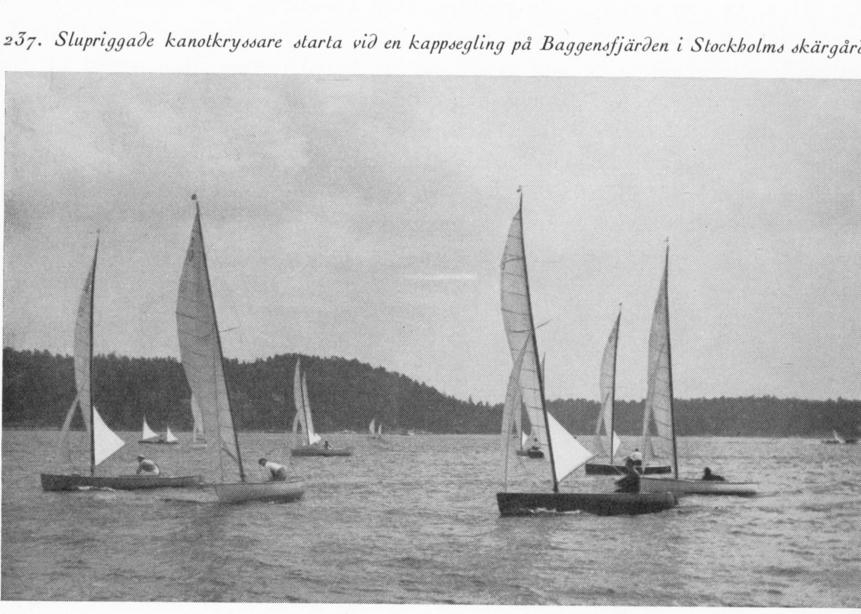
So, the confusion about the modern ‘B’ Class rule and the pre-1931 ‘B’ class rule has been addressed, Zenith is a IIIB design and built before 1924 as the Magnusson designed IIIBs were the only boats being built after this date.
RCC Canoe Rules
We know that Zenith was registered as International Canoe in 1935 as apparently she qualified as RCC ‘B’ Class canoe.
Andrew Eastwood ‘s “From the Rob Roy to the International Ten Square Metre Canoe” has a comprehensive section that covers the the 1894 B class rule, the 1914 B class rule and the 1929 B class rule. Additionally the Royal Canoe Club (RCC) A and B Class Canoes (1910) rules are available from the International Canoe Website.
The salient points, applying to the RCC ‘B’ Class from these rules are:
1894 “B” Class rule
Rule 23: A cruising canoe, to be classified for racing purposes shall be sharp at each end, with no transom or flat stern. Any metal keel, centreplate, or ballast shall be detachable from her, and any ‘bucket well’ fitted within the sleeping compartment shall be detachable.
Dimensions (maximum):
- length overall shall not exceed 16 ft.
- beam not over 42 in.
- sliding seat (if any), when rigged retractable to be within the beam of the boat; her fixed draught, including keel or drop keel, when hauled up, shall not exceed 14 in.
- the extreme length of any spar shall not exceed the load water-line length
Rating length:
- rating (length of LWL x sail area)/6000 not to exceed 0.3
Minimum dimensions
- depth inside, from deck to skin (to be taken at any distance within 3 ft of the mid overall length and not less than 10 in. out from the middle line), shall not be less than 14 in
- depth outside, from top of deck at middle line to underside of keel (taken anywhere up to one foot from either end), shall not be less than 12 in.;
- sleeping space not less than 5 ft 6 in. in length, with hatchway thereto of not less than 18 in. in width for a distance of three feet.
The 1914 “B” Class Rule
Andrew Eastwood states the rules in force in 1908 were substantially the same as those of 1894 except for the overall length allowed being increased to 17 feet and scantling rules being given. These scantling rules were similar to those in the rules in force in 1914.
The main points of the 1914 rule are
- Length overall shall not exceed 17 feet
- Beam not over 3 feet 6 inches.
- Sail area actual total not to exceed 150 square feet. The canoe shall be sharp at each end.
- Depth of body from deck to underside of body at middle line, anywhere inboard of 2 feet from either end, shall not be less than 12 inches.
- There shall be a cockpit opening of not less than 3 feet in length, and not less than 16 inches in width for such length, and the deck on each side of the opening shall not be less than 1/4 the beam of the canoe.
- The planking or skin shall not be less than 1/4 inch in thickness finished; the deck not less than 3/16 inch in thickness, finished; and the bulkheads not less than 3/8 inch thickness, finished. There shall be two transverse bulkheads of wood, one on either side of mid length, but not within 3 feet of either end of the canoe.
- No seat shall be extended beyond the side of the canoe.
- Each canoe in the sailing classes shall bear a distinctive mark and/or number on the mainsail, of such character and colour, as the committee shall from time to time determine.
The 1929 “B” class Rule
- Length overall shall not exceed 17 feet (5.181m).
- Beam not over 3 feet 6 inches (1.067m) excluding rubbing strake.
- Depth of body from top of deck to underside of body at middle line, anywhere inboard of 2 feet (610mm) from either end, shall not be less than 12 inches (305mm).
- The canoe shall be sharp at each end so that the included angle at any level at bow and stern shall not exceed 90 degrees and 135 degrees respectively, and the beam at 2 feet 5.1/2 inches (750mm) from the bow shall not exceed 2 feet 7.1/2 inches (800mm) and the same distance from the stern 2 feet 11.1/2 inches (902mm).
- The outline of any cross section from covering board to keel must be a fair curve, no radius of which shall be less than 2 inches (51mm).
- There shall be two transverse bulkheads of wood on each side of mid-length, but not within 3 feet (914mm) of either end of the canoe.
- The planking or skin shall not be less than 1/4 inch (6.4mm), the deck not less than 3/16 inch (4.8mm) and the bulkheads not less than 3/8 inch (9.5mm) in thickness, the rubbing strake not to exceed 1 inch deep by 5/8 inch thick, all finished dimensions.
- There shall be a cockpit opening of the deck not less than 3 feet (914mm) in length and not less than 16 inches (406mm) in width for such length, and the deck on each side of such opening shall not be less than one quarter of the beam of the canoe.
- Aluminium or its alloys shall not be used in the construction of the hull.
- The Centre plate shall not project more than 3 feet 3.3/8 inches (1m) below the body of the canoe and shall be easily detachable.
- The canoe shall not exceed 15 feet (4.572m) rating
- Notwithstanding any restriction contained in the above Rule, except as regards sail area, any canoe recognised as being a “B” class in the season of 1928 shall not be excluded from competing in club races.
Not quite a ‘B’ Class!
If Zenith was registered in 1935 as an International Canoe because she complied with the rule it could be expected that someone had measured her against the then current (1928) RCC ‘B’ Class rule.
Whilst she complies with the prescribed length, at exactly 17′ (5.181m), her beam is 1.09m, just over the 3’6″ (1.067m) as laid down by the 1928 rule. It was suggested by Ron Head (who took the photo of Zenith in 1953), when I spoke to him just after I took custodianship of Zenith, that as there were so few International Canoes sailing in the 1930s Zenith was invited to join the fleet to increase numbers. This seems a sensible scenario and the 23mm extra beam was ignored.
Reviewing the RCC ‘B’ Class rules has solved one mystery. There are two 1/4″ bulkheads fitted (5’1″ from the stern and 4′ 6″ from the bow). These are clearly a later addition as there are numerous screws that go through the hull into the bulkhead frame, and the quality of the timber used is below that of the rest of the hull. It would appear that these were added as a way of complying with the 1928 RCC ‘B’ Class rule that states “There shall be two transverse bulkheads of wood on each side of mid-length, but not within 3 feet (914mm) of either end of the canoe“
To summarise, Zenith:
- was built to a 1913 IIIB design by Sven Thorell;
- was built at some point between 1913 (when her sistership Sol was designed) and 1924 (as only Magnusson designed IIIBs were built after this date);
- is a ‘sailing’ IIIB design with 10m2 of sail area (as opposed to the ‘racing’ IIIB with 12m2 of sail area);
- arrived in the UK on or before 1935 when she appears in the UK register of International Canoes;
- was considered to be the equivalent to a RCC ‘B’ Class, despite being slightly beamier that a ‘B’ Class;
- was modified to comply with the RCC ‘B’ Class with the addition of two bulkheads.

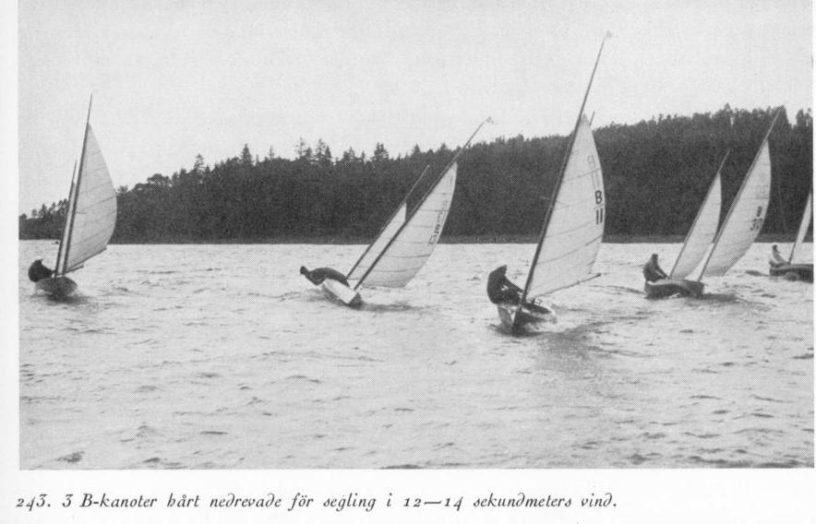
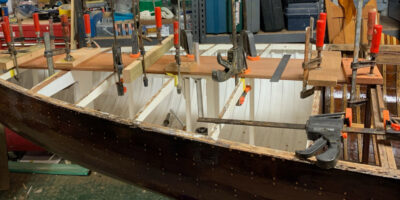
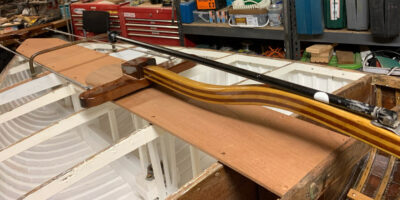
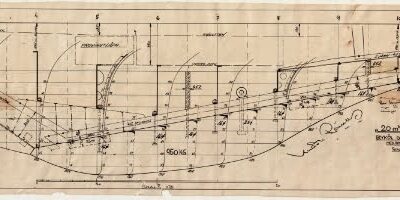
Jim Champ
Good work. I tried and failed to find that sort of Swedish material. I feel there must have been some kind of European input to the International rule set, not just GBR and USA, otherwise why pick 10sq.m. sail area in the 1930s?
neil
Thanks Jim, it took a while and I now know a load of canoe related word in words in Swedish. I bought the eBook “Canoeing: 150 years of joy” published by the FKI and have been pasting pages into Google to translate, it has taken some time.
When I get some more time I’ll have another look at it, though it is worth getting it for some of the photos – available from https://www.adlibris.com/se/e-bok/kanotidrott-150-ar-av-gladje-9789175694030